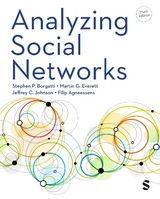
Analyzing Social Networks
SAGE Publications Ltd (Verlag)
978-1-5264-0410-7 (ISBN)
- Titel erscheint in neuer Auflage
- Artikel merken
Designed to walk beginners through core aspects of collecting, visualizing, analyzing, and interpreting social network data, this book will get you up-to-speed on the theory and skills you need to conduct social network analysis. Using simple language and equations, the authors provide expert, clear insight into every step of the research process—including basic maths principles—without making assumptions about what you know. With a particular focus on NetDraw and UCINET, the book introduces relevant software tools step-by-step in an easy to follow way.
In addition to the fundamentals of network analysis and the research process, this Second Edition focuses on:
Digital data and social networks like Twitter
Statistical models to use in SNA, like QAP and ERGM
The structure and centrality of networks
Methods for cohesive subgroups/community detection
Supported by new chapter exercises, a glossary, and a fully updated companion website, this text is the perfect student-friendly introduction to social network analysis.
Stephen P. Borgatti, PhD is the Gatton Endowed Chair of Management at the Gatton College of Business and Economics at the University of Kentucky. He has published extensively in management journals, as well as cross-disciplinary journals such as Science and Social Networks. He has published over 100 peer-reviewed articles on network analysis, garnering more than 80,000 Google Scholar citations. With Martin Everett, Steve is co-author of UCINET, a well-known software package for social network analysis, as well as founder of the annual LINKS Center workshop on social network analysis. He is also a two-term past president of INSNA (the professional association for network researchers) and winner of their Simmel Award for lifetime achievement. Martin Everett is Professor of Social Network Analysis and co-director of the Mitchell Centre for SNA at the University of Manchester. He has published extensively on social network analysis and has over 100 peer-reviewed articles and consulted with government agencies as well as public and private companies. With Stephen Borgatti, Martin is co-author of UCINET, a well-known software package for social network analysis and is co-editor of the journal Social Networks. He is also a past President of INSNA (the professional association for network researchers) and winner of their Simmel Award for lifetime achievement. He was elected as an academician to the UK Academy of Social Sciences in 2004. Jeffrey C. Johnson, PhD is University Term Professor of Anthropology at the University of Florida. He is a former program manager with the Army Research Office (IPA), where he started the basic science research program in the social sciences. He has conducted extensive long-term research, supported by the National Science Foundation, comparing group dynamics and the evolution of social networks of over-wintering crews at the American South Pole Station with those at the Polish, Russian, Chinese, and Indian Antarctic Stations. In related research, he has studied aspects of team cognition and social networks on success in simulated space missions. He is a winner of INSNA’s Simmel Award for lifetime achievement. He has published extensively in anthropological, sociological, biological, aerospace, and marine science journals and was the founding editor of the Journal of Quantitative Anthropology, co-editor of the journal Human Organization, and is the author of Selecting Ethnographic Informants (Sage, 1990).
Chapter 1: Introduction
Why networks?
What are networks?
Types of relations
Goals of analysis
Network variables as explanatory variables
Network variables as outcome variables
Chapter 2: Mathematical Foundations
Graphs
Paths and components
Adjacency matrices
Ways and modes
Matrix products
Chapter 3: Research Design
Experiments and field studies
Whole-network and personal-network research designs
Sources of network data
Types of nodes and types of ties
Actor attributes
Sampling and bounding
Sources of data reliability and validity issues
Ethical considerations
Chapter 4: Data Collection
Network questions
Question formats
Interviewee burden
Data collection and reliability
Archival data collection
Data from electronic sources
Chapter 5: Data Management
Data import
Cleaning network data
Data transformation
Normalization
Cognitive social structure data
Matching attributes and networks
Converting attributes to matrices
Data export
Chapter 6: Multivariate Techniques Used in Network Analysis
Multidimensional scaling
Correspondence analysis
Hierarchical clustering
Chapter 7: Visualization
Layout
Embedding node attributes
Node filtering
Ego networks
Embedding tie characteristics
Visualizing network change
Exporting visualizations
Closing comments
Chapter 8: Testing Hypotheses
Permutation tests
Dyadic hypotheses
Mixed dyadic–monadic hypotheses
Node level hypotheses
Whole-network hypotheses
Exponential random graph models
Stochastic actor-oriented models (SAOMs)
Chapter 9: Characterizing Whole Networks
Cohesion
Reciprocity
Transitivity and the clustering coefficient
Triad census
Centralization and core–periphery indices
Chapter 10: Centrality
Basic concept
Undirected, non-valued networks
Directed, non-valued networks
Valued networks
Negative tie networks
Chapter 11: Subgroups
Cliques
Girvan–Newman algorithm
Factions and modularity optimization
Directed and valued data
Computational considerations
Performing a cohesive subgraph analysis
Supplementary material
Chapter 12: Equivalence
Structural equivalence
Profile similarity
Blockmodels
The direct method
Regular equivalence
The REGE algorithm
Core–periphery models
Chapter 13: Analyzing Two-mode Data
Converting to one-mode data
Converting valued two-mode matrices to one-mode
Bipartite networks
Cohesive subgroups and community detection
Core–periphery models
Equivalence
Chapter 14: Large Networks
Reducing the size of the problem
Choosing appropriate methods
Sampling
Small-world and scale-free networks
Chapter 15: Ego Networks
Personal-network data collection
Analyzing ego network data
Example 1 of an ego network study
Example 2 of an ego network study
| Erscheinungsdatum | 09.04.2018 |
|---|---|
| Verlagsort | London |
| Sprache | englisch |
| Maße | 186 x 232 mm |
| Gewicht | 700 g |
| Themenwelt | Mathematik / Informatik ► Informatik ► Theorie / Studium |
| Mathematik / Informatik ► Informatik ► Web / Internet | |
| Sozialwissenschaften ► Soziologie ► Empirische Sozialforschung | |
| ISBN-10 | 1-5264-0410-9 / 1526404109 |
| ISBN-13 | 978-1-5264-0410-7 / 9781526404107 |
| Zustand | Neuware |
| Haben Sie eine Frage zum Produkt? |
aus dem Bereich



